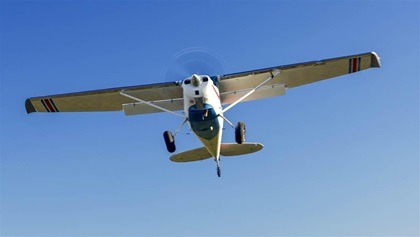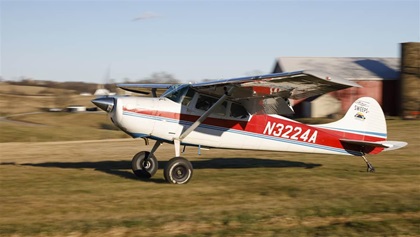Cessna 170 versus Piper Super Cub
Can a modified 170 outperform a backcountry legend?


It approaches any landing area at a stunningly slow speed and stops in mere feet. On takeoff it breaks ground before you think it possible, and quickly achieves an impressively steep climb angle. These are ideal traits for squeezing into challenging grass strips and unimproved landing areas. There is no way a stock Cessna 170 can outperform a Super Cub in its element—but what if the 170 has been modified with 50 additional horsepower (a 35-percent increase), a constant-speed propeller, STOL wing cuffs, and 26-inch tires? We needed to know, and a fly-off was born.
The fly-off took place at a private airport with a 2,000-foot-long grass runway. Both airplanes (full of fuel) were flown solo by experienced tailwheel pilots using standard short-field techniques—me in the AOPA Sweepstakes 1953 Cessna 170B and AOPA Social Media Marketer Erick Webb in a 1993 Super Cub. “We’re just going to see what kind of takeoff and landing distances we can get,” said Webb, “We’re not going to get crazy and do wild STOL things. The pilot who is going to win the airplane can fly it in a similar way to what we’re going to show today.”
Webb took off first. With a maximum gross weight of 1,750 pounds and a 150-horsepower engine, the Super Cub has a power loading of 11.67 pounds per horsepower. The pilot’s operating handbook promises a takeoff roll of 200 feet and a climb rate of 960 fpm. Watching Webb lift off in ground effect and zoom toward the sky, I don’t think the POH was far off. Still, he suggested he was at a disadvantage during this fly-off because he weighs 40 pounds more than me.
 The Sweeps Cessna 170 was up next. Shrugging off its heavier 2,200-pound maximum gross weight with the help of its 195-horsepower Continental Prime IO-370 engine, the 170’s power loading is 11.28. And its Hartzell Trailblazer constant-speed propeller ensures maximum climb performance; no fixed-pitch propeller compromise here. Both airplanes have almost identical wing areas.
The Sweeps Cessna 170 was up next. Shrugging off its heavier 2,200-pound maximum gross weight with the help of its 195-horsepower Continental Prime IO-370 engine, the 170’s power loading is 11.28. And its Hartzell Trailblazer constant-speed propeller ensures maximum climb performance; no fixed-pitch propeller compromise here. Both airplanes have almost identical wing areas.
I set the flaps at 20 degrees, stood on the brakes while I added full power, released the brakes while holding slight up elevator pressure, and let the airplane fly off in a three-point attitude. The 170 broke ground at around 200 feet and climbed at an impressive 1,500 fpm. I found myself instinctively wanting to push forward to lower the pitch attitude and increase airspeed because a 170 shouldn’t be able to climb this steeply. Every subsequent takeoff for both airplanes showed the same result: a tie.
On landing, our touchdown point was a gravel road intersecting the runway at the 500-foot mark—a perfect reference to compare landing roll distances. The Super Cub was way more sensitive to the gusty wind conditions we had this day, bobbing around the sky as Webb worked the airplane down to the runway. The 170—with its higher wing loading—felt more solid on approach. Its huge semi-Fowler flaps and newly installed Sportsman STOL wing cuffs enabled me to slow way down and focus on my aim point. Just below 50 mph indicated—the same airspeed at which the stall warning horn would have previously been blaring—I didn’t hear a peep. It’s comforting to know we now have a bigger safety margin at low speeds. Every touchdown felt pretty smooth whether I bounced it slightly or not—the 26-inch Alaskan Bushwheels easily soaked up any remaining vertical kinetic energy. We both landed within a few feet of the gravel road, but the Super Cub decelerated a little quicker than the 170 on rollout. Our ground rolls were in the 250- to 300-foot range, with the Super Cub consistently stopping 10 to 15 feet shorter than the 170.
That the Sweepstakes 170 is so close to a Super Cub’s outstanding backcountry performance is impressive. “It says a lot about all the improvements that have been done so far,” said Webb. “And then once we get vortex generators and everything else done to it, I think it’s going to be incredible. I think we’ll have to do the test again. I think it might beat the Super Cub by then.”
Let’s be clear: The Super Cub is a lot of fun to fly. The intuitive feeling of a control stick in your right hand and throttle in your left is hard to beat, and the tandem seating provides the best view out of both sides of the airplane. You feel nowhere is out of the realm of landing possibilities while flying this machine.
On the other hand, the Sweeps 170 will carry up to four people and fly faster than the Super Cub (we’re seeing 135 miles per hour in cruise compared to perhaps 115 mph), and it’s way easier to get into and out of. However, the ailerons require more force to move and the roll rate is less sprightly than that of the Super Cub, making it feel less nimble. No matter—the sweet sound and raw power of the engine puts a huge smile on everyone who flies this special Cessna 170. Someday, that could be you.



